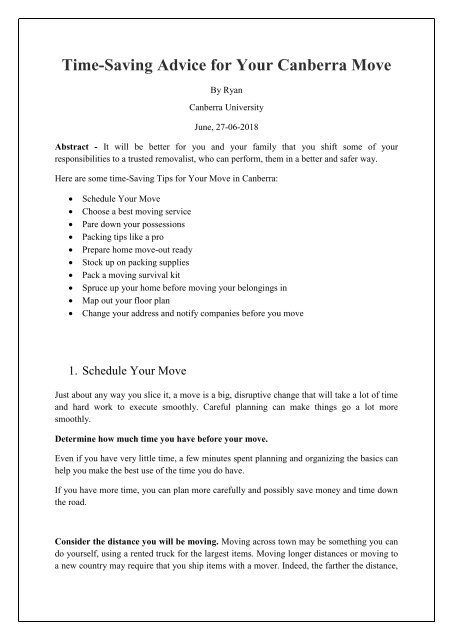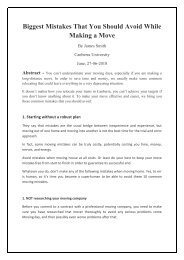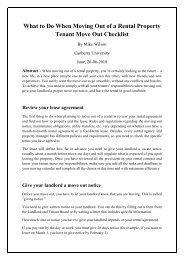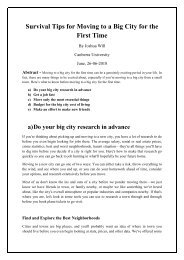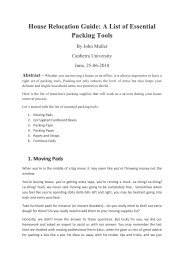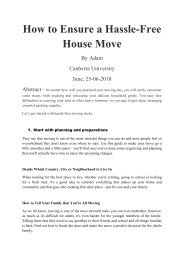Time-Saving Advice for Your Canberra Move
Create successful ePaper yourself
Turn your PDF publications into a flip-book with our unique Google optimized e-Paper software.
<strong>Time</strong>-<strong>Saving</strong> <strong>Advice</strong> <strong>for</strong> <strong>Your</strong> <strong>Canberra</strong> <strong>Move</strong><br />
By Ryan<br />
<strong>Canberra</strong> University<br />
June, 27-06-2018<br />
Abstract - It will be better <strong>for</strong> you and your family that you shift some of your<br />
responsibilities to a trusted removalist, who can per<strong>for</strong>m, them in a better and safer way.<br />
Here are some time-<strong>Saving</strong> Tips <strong>for</strong> <strong>Your</strong> <strong>Move</strong> in <strong>Canberra</strong>:<br />
<br />
<br />
<br />
<br />
<br />
<br />
<br />
<br />
<br />
<br />
Schedule <strong>Your</strong> <strong>Move</strong><br />
Choose a best moving service<br />
Pare down your possessions<br />
Packing tips like a pro<br />
Prepare home move-out ready<br />
Stock up on packing supplies<br />
Pack a moving survival kit<br />
Spruce up your home be<strong>for</strong>e moving your belongings in<br />
Map out your floor plan<br />
Change your address and notify companies be<strong>for</strong>e you move<br />
1. Schedule <strong>Your</strong> <strong>Move</strong><br />
Just about any way you slice it, a move is a big, disruptive change that will take a lot of time<br />
and hard work to execute smoothly. Careful planning can make things go a lot more<br />
smoothly.<br />
Determine how much time you have be<strong>for</strong>e your move.<br />
Even if you have very little time, a few minutes spent planning and organizing the basics can<br />
help you make the best use of the time you do have.<br />
If you have more time, you can plan more carefully and possibly save money and time down<br />
the road.<br />
Consider the distance you will be moving. Moving across town may be something you can<br />
do yourself, using a rented truck <strong>for</strong> the largest items. Moving longer distances or moving to<br />
a new country may require that you ship items with a mover. Indeed, the farther the distance,
the better off you are having reputable professionals take care of everything, including your<br />
pets.<br />
For overseas moves, remember there will be such issues as customs and bio-security<br />
clearances, appropriate shipping methods, and storage issues on arrival.<br />
Assess your budget. Will you hire somebody to move your belongings or rent a truck and do<br />
the job yourself? Do you have money saved up? Do you still have time to set aside the money<br />
you will need? Will an employer cover part of the cost of relocating?<br />
If your employer is assisting you, make sure that everything is in writing, including any<br />
variations agreed upon verbally or otherwise. Things do go wrong, and you need the written<br />
confirmations to ensure that you get reimbursed appropriately.<br />
Written records are also vital when dealing with professional movers. Be sure that you get a<br />
signed-off contract, that you have read all the fine print, and that you have full inventory lists<br />
checked and signed off by both you and the removal company.<br />
Allow some overlap. If your lease or purchase agreement(s) allow, get access to your new<br />
residence be<strong>for</strong>e you must give up your old one. Even a couple of days will spare you the<br />
stress and rush of an overnight move, or the hassle of moving into and out of a storage<br />
facility. A time overlap can also help in case of any delays in closing on the purchase of a<br />
home.<br />
If you must move via a storage unit or if your dates do not overlap, see if there is a service in<br />
your area that will deliver and move storage containers <strong>for</strong> you so that you do not have to<br />
handle your belongings twice. The more moves you have to make in-between arriving at your<br />
destination, the higher the stress levels become and the more frustrated you are likely to feel.
If the move came as a surprise, such as if a landlord decided not to renew a lease or you have<br />
been posted overseas, you should have at least some minimum amount of notice in which to<br />
pack and seek new premises. In this case, your first priority should be to secure new lodgings,<br />
but you may still want to multitask the search <strong>for</strong> a new place with beginning to pack and sort<br />
your stuff, otherwise, you might find yourself running out time.<br />
Too much overlap can be costly. Don't pay double rent <strong>for</strong> longer than you need to. Seek the<br />
garages of friends and family be<strong>for</strong>e paying <strong>for</strong> storage options if possible.<br />
Decide how much you will pare down your belongings. This is a personal choice, of<br />
course, but anything you can part with is something you don't have to move and moving is<br />
always a great time to be brutal with things you don't need or use. Keep in mind that you will<br />
have to balance the time spent to sort your belongings with the monetary cost and ef<strong>for</strong>t<br />
required to pack and move them.<br />
If you move frequently, try to keep a minimum of basic belongings.<br />
If you're downsizing with the move, you will have no choice but to remove things from your<br />
life. This can add to the stress initially but the resulting lower level of possessions is often a<br />
huge release <strong>for</strong> your new way of living.<br />
Start right away if you want to give away or sell belongings, rather than move them.<br />
One alternative to taking that old sofa-bed with you is to sell it or give it away to someone<br />
else be<strong>for</strong>e you leave.<br />
If you have expensive antiques or furniture consider an auction or estate sale.<br />
Craigslist, Freecycle, and the like are excellent resources <strong>for</strong> selling and giving items away.<br />
In some places, you can leave items on the curb and they'll disappear of their own accord in<br />
no time (check with municipal regulations though).<br />
Consider having a garage sale.<br />
Phone local charities to see what used items they can accept. Many can send a truck to pick<br />
up items you do not wish to move.<br />
Many towns now have recycling centers so that you can have your items resold <strong>for</strong> the<br />
benefit of the community rather than simply dumping them to be treated as garbage.<br />
Determine how you will dispose of things that cannot be recycled or donated. If all you<br />
have to do is haul stuff by the armload out to the apartment dumpster, there may be nothing<br />
to plan. On the other hand, if you will be shredding documents, making a run to the dump,<br />
buying extra trash bags, or hiring a hauling company, plan <strong>for</strong> these activities as soon as you
can. Having a dumpster that is easily accessible during your move can make your job much<br />
easier.<br />
Begin using up food. If you have time be<strong>for</strong>e the move, you may want to run through the<br />
usable foods in your pantry and freezer. If you do not have time, or if there are items<br />
remaining that you do not have time to move, see about donating the nonperishable stuff to a<br />
food pantry. You might also give usable items to friends and neighbors.<br />
If moving overseas, carting food and beverages with you is rarely an option. Give away what<br />
you can, from spices to chocolate stashes. Investigate the rules about the carrying and<br />
acceptance of such items as alcohol if you wish to take your special wine cellar overseas with<br />
you. There can be a lot of strict rules surrounding food and alcohol importation, depending on<br />
the country; most countries do not let you move alcohol.<br />
Line up help. Even if moving day is months away, start now to get the help you will need.<br />
The budget option is to call in favors from family and friends. Otherwise, look around <strong>for</strong><br />
someone you can pay to help with packing and moving. Get recommendations from friends<br />
or read ratings if you have the time.<br />
One thing friends can be a huge help with is meals. Once you start packing away your kitchen<br />
equipment, meals become problematic, so accept all offers <strong>for</strong> good food from others.<br />
Friends can also be great babysitters <strong>for</strong> kids and pets, who can often get underfoot or<br />
increase your stress levels when you're worrying about where they are.<br />
On the day of the move, strip all the beds, including the mattress pads, and gather the used<br />
towels. Get a neighbor to wash, dry, and fold everything, then pack all together in one box <strong>for</strong><br />
immediate use in the new place.<br />
Plan <strong>for</strong> any special or challenging objects you must move. If you and your friends can<br />
move the sofa, fine. But if you have anything especially large, heavy, or fragile to move (such<br />
as a piano), you may need specialized help.<br />
When moving long distances, ask the removal company about their wrapping and packaging<br />
techniques, as well as their policies with respect to breakages.<br />
If asking others to remove valuable items, get references from people who have used their<br />
services and been satisfied with them.<br />
Make a list of people and organizations you will need to contact. When you move, you<br />
should in<strong>for</strong>m government agencies, institutions with which you do business, utilities, and so
on. Make this list as soon as you know you will move, and continue to update it as monthly<br />
bills and statements remind you of whom you should in<strong>for</strong>m.<br />
In some countries, the post office offers a standard <strong>for</strong>m with a list of names that you can<br />
check and they will advise the most obvious companies and agencies that you have moved.<br />
Inquire at your local post office <strong>for</strong> more in<strong>for</strong>mation.<br />
Consider mail <strong>for</strong>warding <strong>for</strong> a while. Although this can cost money, it is better than having<br />
your mail go astray until you've caught up with all the address changes.<br />
If you cannot <strong>for</strong>ward your mail to a <strong>for</strong>eign country ask a trustworthy friend, or family if you<br />
can <strong>for</strong>ward it to them. They can hold the important mail and throw away the unimportant.<br />
Consider opening a joint account with a family member or friend that you can access online.<br />
This way if you need bills paid you can transfer funds and have them pay with them.<br />
Organize any repairs or cleaning. If the new place must be cleaned or repaired be<strong>for</strong>e you<br />
move in, plan overlapping time or time with your belongings in storage to complete these<br />
tasks. If you must clean or repair the home you are leaving (such as to recoup a cleaning<br />
deposit or to leave it respectable <strong>for</strong> the buyers), plan that time, as well. Remember that<br />
cleaning is generally easiest and most effective in an empty residence.<br />
If you have purchased a new home, in<strong>for</strong>m the real estate agent that you would like a time set<br />
aside <strong>for</strong> a cleaning company to assess the cost of cleaning be<strong>for</strong>e settlement is complete, if<br />
possible. This allows you to set up the cleaning well in advance and also encourages the<br />
seller to be more prudent in cleaning out their stuff because you'll be aware of what needs to<br />
be cleaned and can raise particular concerns. It is demoralizing to move into a new home with<br />
the old grime and junk of the previous owner still there.<br />
Reserve a truck. If you will be renting a truck, using a shipping or moving company, then<br />
reserve your time as soon as you know that you will need it. In some areas and at some times<br />
of year (such as college towns at the end of the school year), the demand may be very high<br />
and you might have to wait longer than intended <strong>for</strong> a free spot.<br />
List and secure any needed supplies. Boxes, newspaper, packing tape, and markers are the<br />
basics. Do you also need carts or dollies, any special carrying cases, or anything else?<br />
Some companies sell quality moving boxes in bulk. This might be a good deal considering<br />
the boxes will be made <strong>for</strong> carrying items intended <strong>for</strong> household removal and won't be<br />
flimsy or strangely shaped as supermarket boxes can be.
Labels such as "fragile", "this way up", and explaining the contents and room, etc., can be<br />
made up on your home computer with ease. Just be sure to tape them on securely.<br />
Check Craigslist or Freecycle if it is active in your area and time permits. You may find<br />
moving boxes and packing materials that others have just emptied.<br />
Start at least a basic plan <strong>for</strong> how you will arrange your belongings in the new home. If<br />
you can, label or mark each box with where you want it to go rather than where it came from.<br />
(Often, this may be the same, since items coming out of the kitchen probably will go back<br />
into the kitchen.)<br />
Plan and pack a survival kit. These are the items you will keep out or keep separate so that<br />
you have the most essential items at hand when you first arrive. These items might go in a<br />
specially labeled box or in suitcases. You will know best which items to pack <strong>for</strong> yourself,<br />
but remember to include medications, eyeglasses, wallets and ID, plus a few changes of<br />
clothes. If pets will move with you, include the basics you need to care <strong>for</strong> them, as well.<br />
It's a good idea to pack one box with a teakettle, a small pot, some teabags/coffee/cookies,<br />
some cutlery, a few plates, a toaster, some hand towels and liquid soap, etc. <strong>for</strong> those muchneeded<br />
things when you first arrive. This will save you from rummaging around <strong>for</strong> basics<br />
and allow you to get on with the business of unpacking methodically.<br />
Plan to pack less-frequently used items first. Especially if you have plenty of time to pack,<br />
start early, packing things like books and clothing that is out of season. You will unpack in<br />
approximately the reverse order.<br />
2. Choose a best moving service<br />
Let’s face it; moving around Australia is not only stressful but expensive too and there<strong>for</strong>e,<br />
you must take precautions otherwise, it might turn into a nightmare. To be on the safe side,<br />
you need to find a reputable removalist that you can trust to handle your items with great<br />
care. I know you’re asking yourself how to find the right removal company that you’ll trust<br />
with your valuable goods. If that’s the case, read along and find out how you can go about it.<br />
The good news is that removalists are not only many and competent but af<strong>for</strong>dable too. The<br />
following tips will help you settle <strong>for</strong> a high quality removalist.<br />
Start local
Instead of going straight to the internet, it’s advisable that you start your search locally. The<br />
first step there<strong>for</strong>e is to call some local real estate agents and ask them to give you the names<br />
of some of the local moving companies in your local area or those with their offices nearby.<br />
Get more than three removal companies and contact them to find out about their terms of<br />
services.<br />
Comparison<br />
Set up appointments with different removalists to come to your house and let each of them do<br />
an in-house estimate. It’s advisable that you don’t settle <strong>for</strong> the first moving company you<br />
contact but find out and compare their terms of services be<strong>for</strong>e hiring. Everybody want to<br />
save so; compare their prices and then choose the one with the most logical price and which<br />
will not compromise its services.<br />
Experience<br />
Find out how long a removal company has been in business <strong>for</strong> many years. In that way, you<br />
can be sure that they have enough expertise that you require.<br />
Don’t allow <strong>for</strong> sub-contracting<br />
You should find out upfront whether the removal company will do the moving itself or will<br />
be sub-contracting the work to another removal company. A high quality company is that<br />
which will do the moving itself and if that’s not the case, keep searching.<br />
Facilities
Find out whether a removal company has all the necessary equipment to carry out the<br />
exercise. A quality removalist must have its trucks permanently marked with the name of the<br />
company. Do they have enough packing boxes? A quality removal company must have many<br />
boxes of different shapes and sizes <strong>for</strong> packing all your goods including the fragile ones.<br />
Paperwork<br />
A reputable moving company will explain into details the paperwork be<strong>for</strong>e asking you to<br />
sign. Don’t you ever sign a paperwork that you’ve not understood well or a blank one.<br />
Rights and responsibility<br />
All quality removal companies will provide you with a booklet that contains your rights as<br />
well as responsibilities. If a company doesn’t do that, then keep searching.<br />
Go online<br />
Be<strong>for</strong>e you choose a removalist, it’s now time to find more in<strong>for</strong>mation online. Check<br />
whether the in<strong>for</strong>mation you’ve gathered matches with what you find in the internet. Read<br />
customer reviews and read the comments from customers who have heard fast hand<br />
experience with that removalist. If the customers are happy, then the moving company is of<br />
quality otherwise send them packing. There are a number of online services that allow you to<br />
compare removalists quickly and easily. Utilising an online service such as these allow you to<br />
cut down on the time and ef<strong>for</strong>t required to find a removal company.<br />
3. Pare down your possessions<br />
In a few weeks I’m moving across the country—from a 1,400 sq. ft. house to a 900 sq. ft.<br />
apartment. Though I consider myself generally minimalist, my little family has lived in our<br />
home <strong>for</strong> almost four years, and some things... and stuff... and crap... have naturally<br />
accumulated over time. Now it’s time to downsize—to revaluate what does and does not<br />
“make the move.”<br />
At first it felt like a huge chore, like a million small yet annoying and potentially-backfiringon-me<br />
decisions to make. But I shifted my mindset, and now I’m really excited about it. I’ve<br />
realized that moving is an opportunity to uplevel: to reassess what I own and edit out<br />
anything that no longer fits my life (or the new chapter I’m about to begin).<br />
This is a chance to re-evaluate my wardrobe, my kitchen appliances and utensils—even my<br />
precious books.
Don’t think of paring down as something you have to do; think of it as a chance to start<br />
fresh.<br />
Put another way: You get to move only your best stuff! This is permission to get rid of, say,<br />
that piece of cheap-ish fiberboard furniture you bought years ago <strong>for</strong> some weirdly specific<br />
use and have just been dragging along with you ever since. Or your old towel set that you<br />
kept even after you bought some new ones. Or your third set of measuring cups. You’ll know<br />
the unnecessaries when you see them.<br />
Just because you own it now, doesn’t mean to you have to take it with you.<br />
Forget “sparking joy”—is this thing worth hauling across the country? Does it earn its keep<br />
enough to pack it, transport it, unpack it, then find a place <strong>for</strong> it in your new space?<br />
Do you have multiples of it? Is it worn out, or has it been unused <strong>for</strong> more than a year? Does<br />
it have a place in your new home/chapter? Paring down now will save you time (and space)<br />
later. And if you’re struggling to part with an object of nostalgic value, remember: You can<br />
keep the memory without keeping the object.<br />
Reap the rewards of living with less.<br />
You’re not just throwing this stuff away (...right?!). You can sell things if you need/want<br />
some extra money <strong>for</strong> the move, or simply donate them if you’re just done with them. That’s<br />
my preferred method.<br />
I also take com<strong>for</strong>t in knowing that all the items I’m donating are going to someone else who<br />
really does need and want them—it makes it easier <strong>for</strong> me to part with them, too.<br />
Out with the old… and in with the new.
When I get rid of something practical, I start a running list (or even more efficient: an<br />
Amazon shopping cart) of things I’ll need when I get to my new home. Whether it’s a new<br />
broom, laundry detergent, a tupperware set, or nicer hangers (just to name a few), I don’t<br />
have to remember everything—but they don’t get <strong>for</strong>gotten either—and I can hit the ground<br />
running with new household essentials once I get to my new place.<br />
4. Packing tips like a pro<br />
Are you packing to move or are you packing to travel? Either way, we'll help you find<br />
a way to do it efficiently so that you can get the most out of your experience. Packing<br />
of any kind can be stressful but with some strategy, tips, and motivation, it can<br />
actually be a fun experience.<br />
Sort through all of your stuff first. Start your moving process by getting rid of the items<br />
that you don't need. There's no sense in organizing and trying to pack a bunch of stuff that<br />
you'll just get rid of anyway, so pick through your home meticulously and get rid of as much<br />
as you can. Go room by room and look <strong>for</strong> items that you haven't used at all in the last year.<br />
Chances are, if more than a year goes by without use, you probably don't need the item.<br />
Everyone has sentimental knickknacks and old papers that they don't want to get rid of. That's<br />
fine. But a healthy practice is to keep a small or medium size box that's devoted to these<br />
items. Keep only what you can fit in the box. If you want to put in things that are new, you<br />
have to empty out things that don't matter to you quite as much any more. This practice will<br />
keep you from hoarding items.<br />
Find some boxes. Next you'll want to get some boxes to pack items in to. You might want to<br />
use plastic bins <strong>for</strong> some items, like papers and clothes, which are sensitive to water and<br />
staining. This will keep them from getting damaged. For most other items however,<br />
cardboard boxes are the way to go. Use mainly small and medium size boxes and pack them<br />
no heavier than 50 lbs.
You can often buy cheap cardboard boxes from auto shops and hardware stores. Avoid the<br />
boxes sold by moving companies, as they are often more expensive.<br />
You can also get boxes <strong>for</strong> free, although they might not be in as good condition. Go to<br />
grocery stores, wholesale stores, large cafeterias or restaurants, and liquor stores and ask if<br />
they have any boxes you can have <strong>for</strong> moving. Since they have to take the cardboard to the<br />
recycling anyway, they're usually happy to give the boxes away. Liquor store boxes are best<br />
<strong>for</strong> moving, since they're designed to carry very heavy items without breaking.<br />
Get some tools. You will want to rent a few items from your local hardware store or moving<br />
company, in order to make this process easier and less back-breaking. Mainly, you'll want a<br />
hand truck and possibly a dolly. These will help you transport very heavy items and more<br />
than one item at once, speeding up the process and making it easier on your body.<br />
Of course, you'll want other items too. Tape, shrink wrap, pens <strong>for</strong> labeling, scissors, box<br />
cutters, twine and cords are all very useful <strong>for</strong> packing and moving.<br />
Set aside items you'll need immediately. Make a separate box or bag with all the things that<br />
you'll need <strong>for</strong> the first few days after moving. Put things inside like a few changes of clothes,<br />
your toiletries, a roll of toilet paper, a few plates and utensils, and maybe a frying pan. This<br />
will save you from having to dig through a bunch of boxes right away to get at the things you<br />
need most.<br />
Remember to tape the lids closed on liquid items and wrap them in bags. You don't want all<br />
of your immediately needed items to be covered in shampoo.<br />
Separate out really important or valuable items. For items that are really important, like<br />
all of your moving documents and important documents like birth certificates, you will want<br />
to have a separate box or bag. You should also put very expensive items in this box, like your<br />
mp3 player and your grandmother's jewelry. This box should be transported in your car with<br />
you or on your person.<br />
If you're moving very far, it might be a good idea to have this box shipped ahead of you.<br />
Send it to your new home if someone is waiting there to receive it or have it shipped to<br />
someone you trust.<br />
Start organizing. Now that you've got all that done, you can start going through the rest of<br />
the items in your home. Go room by room and try to keep similar items together. Place<br />
heavier items at the bottom of boxes and try to evenly distribute the weight between boxes.<br />
Make sure the box is full and if it's not, fill it with packing paper. If the top of the box has
nothing below it, it will be more prone to collapsing, which can break the items in your box.<br />
As you pack, be sure to label everything clearly.<br />
Make an inventory list as you go, numbering the boxes and indicating which important items<br />
are in which boxes (as well as how many boxes there are). You can also use color-coded tape<br />
to indicate which room boxes belong in, <strong>for</strong> example making all boxes <strong>for</strong> the living room<br />
green and all boxes <strong>for</strong> the kitchen yellow.<br />
Pack delicate items cleverly to keep them from breaking. You're probably acquainted with<br />
the idea of wrapping delicate items in newspaper or bubble wrap. These are both very good<br />
practices and you should definitely wrap items which are prone to breaking. However, you<br />
should consider also using non traditional items, since sometimes these can be doubled up to<br />
save you packing space.<br />
For example, wrap your glasses in pairs of clean socks and your picture frames can be<br />
wrapped in towels.<br />
You should also remember to wrap items to support them. Items with holes at the center or<br />
long arms should be wrapped to give them support and make them look more like solid<br />
objects. This will keep them from getting broken.<br />
Make sure any boxes that do contain delicate items are marked as fragile. This will help you<br />
decide how to organize boxes in the truck and keep you from accidentally breaking items.<br />
Make good use of space. Look <strong>for</strong> any place where there is empty space and use it <strong>for</strong><br />
packing space. This can reduce the overall footprint of your move, saving you money on<br />
trucks or containers. Large furniture items are usually the best example of spaces that can be<br />
multipurpose.<br />
For example, you can stuff linens in your fridge. <strong>Your</strong> dresser drawers can filled with rolled<br />
up clothes and saran wrapped individually. Since the drawers are best carried in to your new<br />
home one at a time anyway, you can use the space so that the dresser space isn't wasted when<br />
it's in the truck.<br />
Stay focused and motivated. Most importantly, you're going to want to stay focused and<br />
motivated. Even the most fastidious packer can move at a snail's pace if they get bored and<br />
distracted. Pack with other people, making it a social gathering. If you can't do that, at least<br />
put on your favorite movie or an energetic soundtrack. This will help keep you on task.<br />
Start with the most difficult items to pack. This means that by the end, when you're getting<br />
tired, you'll be able to knock out the easy items just like that.
Load it up! Once you’re done packing, load the boxes and items into a truck or other<br />
transportation method <strong>for</strong> getting them to their final destination. Put the tools, like the hand<br />
truck, that you got to good use and be sure to strap everything down. You may also want to<br />
wrap large items, like bed headboards and dressers, in blankets, in order to keep them from<br />
getting scratched by boxes.<br />
5. Prepare home move-out ready<br />
Most movers won't disconnect anything that's hard-wired into your house, so unplug<br />
appliances and lighting fixtures if you're taking them with you. Make sure all paths are clear<br />
from your house to the moving truck. You can also help out your movers and speed up the<br />
process by knowing the ground rules <strong>for</strong> what they will and won't move -- movers won't<br />
touch flammable items, perishable foods or plants.<br />
6. Stock up on packing supplies<br />
Avoid the dilemma of running out of packing tape the morning of your move by having<br />
plenty of supplies on hand. Early on in your moving process, start gathering boxes, tape,<br />
bubble wrap, newsprint, box cutters and markers. You can also save time and the<br />
environment by packing with materials you already have. Load up your suitcases and plastic<br />
containers and use pillows, scarves and towels to protect fragile items.<br />
7. Pack a moving survival kit<br />
Don't throw everyday essentials in with your other belongings, only to have to dig through<br />
boxes later searching <strong>for</strong> your ID or your medications. Instead, pack a "last-to-go" box with<br />
all of the necessities -- toiletries, snacks, important documents and the like -- and keep it with<br />
you rather than on the moving truck.<br />
8. Spruce up your home be<strong>for</strong>e moving your belongings in<br />
It's easier to clean, paint and make other improvements while your home is still empty.<br />
Be<strong>for</strong>e you haul in your furniture and boxes, vacuum, dust the baseboards, wash the kitchen<br />
and bathroom floors, and paint the walls.<br />
9. Map out your floor plan
Give your back a break by deciding how you want to arrange your furniture be<strong>for</strong>e moving it<br />
into the house. The best way to do this is to make newspaper cutouts of the furniture.<br />
Measure the dimensions of the item and tape together newspaper pages to match the<br />
"footprint" of the furniture. This allows you to easily try out several floor plans without<br />
repeatedly reshuffling your furniture.<br />
10. Change your address and notify companies be<strong>for</strong>e you move<br />
Filling out a change of address <strong>for</strong>m be<strong>for</strong>e you skip town can prevent major hassles like<br />
past-due bills, service lapses and even identity theft. Prior to your move, you should also<br />
schedule dates to discontinue your utilities, phone, cable and Internet and arrange <strong>for</strong> these<br />
services at your new address. Several new services even let you save time by doing all your<br />
utilities hook-ups online.<br />
Conclusion<br />
Hiring an experienced moving company reduces the stress, saves time, and gives you a peace<br />
of mind. Just make sure you hire professional removal company in <strong>Canberra</strong> that gives 100 %<br />
damage-free guarantee while packing, loading and unloading your stuff.<br />
Reference<br />
Shannon Petrie | Top 10 <strong>Time</strong>-<strong>Saving</strong> Tips <strong>for</strong> <strong>Your</strong> <strong>Move</strong> | HGTV. Retrieved on 15-06-2018<br />
from<br />
https://www.hgtv.com/design/real-estate/top-10-time-saving-tips-<strong>for</strong>-your-move<br />
How to Plan a <strong>Move</strong> | WikiHow. Retrieved on 15-06-2018 from<br />
https://www.wikihow.com/Plan-a-<strong>Move</strong><br />
BetterRemovalists<strong>Canberra</strong>(2017) | How To Ensure the Safety Of Antiques During a House<br />
<strong>Move</strong> | Better Removalists <strong>Canberra</strong>. Retrieved on 27-06-2018 from<br />
https://www.betterremovalistscanberra.com.au/ensure-safety-antiques-house-move/<br />
Liz Johnson(2017) | 4 Tips <strong>for</strong> Paring Down <strong>Your</strong> Belongings Be<strong>for</strong>e a Big <strong>Move</strong> | Food52.<br />
Retrieved on 15-06-2018 from
https://food52.com/blog/19379-4-tips-<strong>for</strong>-paring-down-your-belongings-be<strong>for</strong>e-a-big-move<br />
How to Pack Like a Pro | WikiHow. Retrieved on 15-06-2018 from<br />
https://www.wikihow.com/Pack-Like-a-Pro


